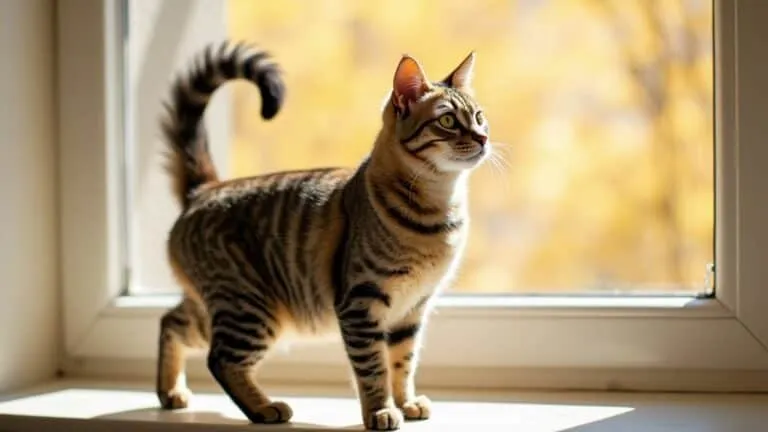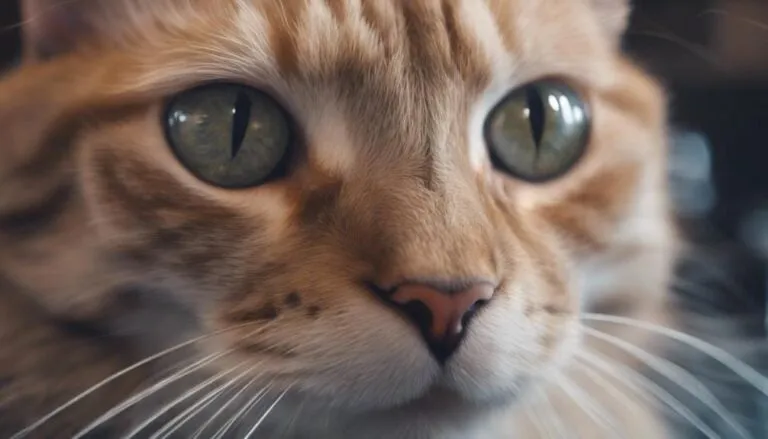The Best Fluffy Pancakes recipe you will fall in love with. Full of tips and tricks to help you make the best pancakes.

Imagine the graceful arc of a cat's tail as it flicks in the air, a subtle yet meaningful gesture that holds the key to understanding your feline companion's mood and intentions.
By deciphering these subtle cues and learning to speak your cat's language, you can unlock a deeper connection with your pet that goes beyond mere cohabitation.
Understanding the intricacies of your cat's behavior will not only strengthen your bond but also enrich your shared experiences in ways you never thought possible.
Key Takeaways
- Observe feline body language for cues on emotions and needs
- Engage in interactive play to build trust and strengthen bonds
- Provide a safe environment with hiding spots and interactive areas
- Enrich your cat's life with toys, scents, and stimulating activities
Decoding Feline Body Language
When trying to understand your feline friend, pay close attention to their body language cues. Cats are like expert communicators, using their tails, ears, and eyes to express themselves.
For instance, a cat with ears forward is likely curious or engaged, while flattened ears indicate fear or aggression. Keep an eye on those pupils too; dilated ones show excitement, while constricted pupils may mean fear or stress.
A relaxed cat will have a calm body posture and may even flick its tail slightly to show contentment and trust. However, hissing or growling are defensive behaviors, signaling that your cat feels threatened or uncomfortable.
Establishing Trust Through Play
To build a strong foundation of trust with your feline companion, engaging in playful activities is key. Playing with your cat not only provides entertainment but also serves as a powerful tool to deepen your bond. Through interactive play sessions, you can show your cat that you are a source of fun and joy, fostering positive interactions and strengthening the connection between you both.
| Benefits of Playing with Your Cat | |
|---|---|
| Encourages Trust and Comfort | Strengthens Bond |
| Understand Preferences and Behaviors | Enhances Communication |
| Reduces Stress and Anxiety | Promotes Stimulation |
| Improves Overall Well-being and Happiness | Leads to Harmonious Relationship |
Creating a Kitty-Safe Environment
You care deeply for your feline companion, and creating a safe environment for them is crucial. Make sure to provide safe hiding spots for when they need to retreat and relax.
Implement cat-proofing tips like securing cords and wires to prevent accidents and injuries.
Set up interactive play areas to keep your cat engaged and mentally stimulated, promoting their overall well-being.
Safe Hiding Spots
In creating a kitty-safe environment, offering secure hiding spots in high, enclosed spaces is crucial for your feline friend's comfort and well-being. Cats feel secure in cozy hideaways like cat trees, shelves, or perches, providing them with secure retreats to observe their surroundings without feeling threatened.
Peaceful sanctuaries such as cardboard boxes, paper bags, or covered beds can serve as comforting hiding spots for your cat. Having multiple hiding spots in various rooms caters to different preferences, ensuring your feline companion always has a safe space to retreat to.
These safe hiding spots help reduce stress and anxiety in cats, ultimately promoting their overall well-being and happiness. Remember, creating a peaceful environment with secure hiding spots is a simple yet effective way to ensure your cat feels safe and content.
Cat-Proofing Tips
Creating a kitty-safe environment involves securing electrical cords and outlets to prevent potential hazards for your curious feline friend. Cats are naturally drawn to exploring their surroundings, which can sometimes lead them into dangerous situations.
Be mindful of your cat's behavior and tendencies when cat-proofing your home. Use barriers like baby gates to restrict access to areas like balconies or stairs that could pose a risk. Additionally, ensure toxic plants and chemicals are out of reach to prevent poisoning risks. Keep small objects away to avoid choking hazards.
Providing vertical spaces for climbing and interactive toys for feline exploration can help satisfy your cat's natural instincts in a safe environment.
Interactive Play Areas
When setting up interactive play areas for your feline friend, consider designating specific spaces with engaging toys and structures that cater to their natural instincts. Incorporate climbing structures and hiding spots to encourage exploration and physical activity. Remember to rotate toys regularly to prevent boredom and keep your cat mentally stimulated. Use interactive toys like laser pointers or feather wands to mimic hunting behaviors and promote active play sessions. Always supervise playtime to ensure safety and intervene if needed. By creating a kitty-safe environment with interactive toys and enrichment opportunities, you're providing your cat with the stimulation they need to stay happy and healthy. Your furry friend will thank you for it with lots of purrs and playfulness!
| Interactive Toys & Enrichment | Climbing Structures & Exploration |
|---|---|
| Feather Wands | Cat Trees |
| Laser Pointers | Wall Shelves |
| Puzzle Feeders | Tunnels |
| Ball Tracks | Window Perches |
Understanding Cat Communication Cues
Understanding your cat's communication cues involves paying close attention to their vocalizations, body language, and behaviors to decipher their needs and emotions effectively. Cats use a range of sounds to communicate, with meows having different meanings like hunger, thirst, or a call for attention.
Additionally, observing your cat's tail can provide valuable insights into their mood and intentions. The position and movement of their tail can indicate feelings of happiness, agitation, or even aggression. Purring is another significant form of communication for cats, expressing contentment, pleasure, or sometimes discomfort.
By understanding the context, accompanying body language, and consistency of these cues, you can better respond to your feline friend's messages. Remember, each cat is unique, so familiarizing yourself with your cat's individual communication style will strengthen your bond and ensure a harmonious relationship.
Paying attention to meow meanings, tail talk, and purr power will enhance your ability to understand and connect with your beloved pet on a deeper level.
Building a Strong Bond With Your Cat
To build a strong bond with your cat, engaging in interactive play sessions is crucial.
This not only fosters trust but also allows for communication cues and signals to develop naturally.
Trust Through Playtime
Engage your feline friend in interactive play sessions to strengthen trust and build a strong bond between you and your cat. Trust building through play techniques involves using toys that mimic prey, fulfilling your cat's hunting instincts.
Rotate toys regularly to keep playtime engaging and mentally stimulating. Incorporate interactive games that encourage bonding and provide opportunities for positive reinforcement, such as treats or praise.
Spending quality time playing with your cat not only enhances communication cues but also fosters a deeper understanding between you both. Remember, these playtime engagements are crucial for not only physical exercise but also for nurturing a strong emotional connection with your beloved feline companion.
Communication Cues and Signals
When deciphering your cat's communication cues and signals, tuning into their subtle body language and vocalizations can unveil a deeper connection and understanding between you and your feline companion. Understanding these cues is key to building a strong bond with your cat.
Here are some crucial communication cues to look out for:
- Meow translation: Decoding the different types of meows can help you understand your cat's needs and emotions better.
- Tail flicks: The way your cat moves its tail can indicate its mood or level of agitation.
- Purring patterns: Pay attention to the variations in your cat's purring, as they can signify contentment or stress.
- Body language: Observing your cat's posture and gestures can provide valuable insights into its feelings.
- Eye contact: The way your cat looks at you can convey affection, playfulness, or even a warning.
Recognizing Signs of Stress in Cats
If your feline friend is exhibiting signs of stress such as excessive grooming or hiding, it's important to pay attention and address the underlying causes promptly. Recognizing these signs is crucial for your cat's well-being as stress can impact their mental well-being and overall happiness.
| Signs of Stress in Cats | Behavioral Changes | Physical Symptoms |
|---|---|---|
| Excessive grooming | Aggression | Dilated pupils |
| Hiding | Changes in appetite | Flattened ears |
| Agitation | Vocalization | Tail twitching |
Changes in appetite, vocalization, or litter box habits can also indicate stress in cats. Stressors for your cat may include new environments, loud noises, or changes in routine. To help manage your cat's stress, provide a safe and quiet space, engage in calming activities, and ensure they have a predictable routine. Remember, recognizing and addressing stress in your cat is essential for their overall well-being.
Providing Enrichment for Your Cat
To provide enriching experiences for your cat, consider incorporating interactive toys, puzzle feeders, and climbing structures that align with their natural instincts. Engaging your feline friend in activities that stimulate their senses and encourage physical and mental activity is essential for their overall well-being.
Here are some enrichment ideas for your cat:
- Rotate Toys: Keep things interesting by introducing new toys and rotating them regularly to prevent boredom.
- Scent Enrichment: Enhance sensory exploration by incorporating scents like catnip, silver vine, or cat grass into their environment.
- DIY Toys: Get creative and make your own toys using household items to provide mental stimulation.
- Designated Play Area: Create a designated space with different textures and surfaces to satisfy their need for sensory stimulation and play.
- Environmental Stimulation: Offer scratching posts, window perches, and hiding spots to create a dynamic environment that promotes exploration and engagement.
Nurturing Your Cat's Natural Instincts
Nurturing your cat's natural instincts involves encouraging their innate behaviors through interactive play and providing appropriate environmental stimuli. Indoor enrichment plays a vital role in satisfying your cat's natural behaviors. Cats have a strong instinct for hunting and stalking prey, which can be fulfilled by engaging them with interactive toys. Puzzle feeders or hiding treats around the house can mimic hunting behavior, providing mental stimulation and satisfying their predatory instincts.
Vertical spaces like cat trees or shelves cater to their instinct to perch and observe their surroundings, promoting a sense of security. Scratching posts are essential for maintaining your cat's claws and allowing them to mark their territory, as they've scent glands in their paws. Additionally, creating safe outdoor enclosures or offering window perches can enable your cat to experience the outdoors safely, stimulating their natural curiosity.
Resolving Common Cat Behavior Issues
Understanding common cat behavior issues is essential for strengthening your bond with your feline companion and ensuring their well-being. When faced with behavior problems, it's crucial to approach them with patience and understanding.
Here are some key strategies to help you address and resolve common cat behavior issues:
- Behavior modification techniques: Utilize methods like redirection and desensitization to modify unwanted behaviors effectively.
- Feline training methods: Consistency and positive reinforcement are key when training your cat to follow commands or stop certain behaviors.
- Positive reinforcement strategies: Reward good behavior with treats, praise, or playtime to encourage your cat to repeat those actions.
- Recognizing signs of stress: Understanding your cat's body language can help you identify stress or anxiety triggers and address them promptly.
- Seeking expert advice: Consulting a cat behavior specialist can provide valuable insights and personalized solutions for your cat's specific behavior issues.
Frequently Asked Questions
How Do You Help Cats Recognize Each Other?
To help cats recognize each other, encourage mutual grooming or scent swapping. Utilize visual cues like body language and vocal communication. Establish a shared scent environment by using the same brush on each cat to promote friendly behavior and bonding.
What Body Language Do Cats Fight With?
When cats fight, they use body language like puffed fur, flattened ears, dilated pupils, and hissing. Understanding aggression signals helps in interpreting their emotions. To resolve conflicts, observe tail lashing and raised hackles for potential escalation.
How Do You Understand a Cat's Feelings?
To understand a cat's feelings, pay attention to body language, vocalizations, and behaviors. Recognizing emotions through tail position, ear movements, and eye contact is vital. Building trust and communicating effectively with your feline friend enhances your bond.
What Is a Cat's Body Language When They Are Scared?
When your cat is scared, watch for flattened ears, dilated pupils, hiding, tucking tail, or vocalizations like hissing. To calm them, avoid fear triggers, offer safe spaces, gentle petting, soothing tones, and reassuring presence.
Conclusion
Now that you have learned how to decode your feline friend's behavior, establish trust through play, and create a safe environment for them, you're well on your way to building a strong bond with your cat.
By recognizing their communication cues, providing enrichment, and nurturing their natural instincts, you can ensure a happy and harmonious relationship with your beloved pet.
Remember, understanding your cat is the key to a fulfilling companionship.










